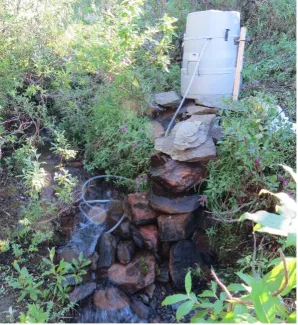The concentration-discharge dynamics of a small (~2.25 km2) headwater catchment underlain with discontinuous permafrost were evaluated. Concentration-discharge (C-Q) dynamics are routinely used to deduce hydrological or biogeochemical processes occurring at the catchment-scale, such as: solute sources, hydrological flowpaths, residence times, storage dynamics, weathering processes, and biogeochemical behavior. Several recent studies have noted that the concentrations of mineral weathering products are often exceptionally stable relative to stream discharge and have termed this phenomenon “chemostatic” behavior. Chemostatic behavior appears to be widespread, with the majority of catchments previously studied exhibiting chemostatic C-Q dynamics for weathering products (e.g., Ca, Mg, Na, and Si). The presence of any permafrost and an annual active layer imposes unique catchment hydrology strongly controlled by the three-dimensional configuration of subsurface permafrost and the active layer. This configuration is non-trivial and varies both spatially and temporally. The spatial and temporal dynamics caused by permafrost make it unclear whether a permafrost underlain catchment is likely to exhibit the same chemostatic behavior widely observed in lower-latitude catchments. The primary goal of this work was to investigate the extent of chemostasis in a headwater catchment underlain with discontinuous permafrost. Our observations suggest that most mineral weathering products do exhibit chemostatic behavior in discontinuous permafrost catchments under typical catchment conditions, but also revealed nuances related to the solutes being studied and the local meteorological conditions. The widely observed chemostatic behavior suggests that the catchment storage and residence times were sufficiently long for weathering reactions to approach equilibrium, even in a spatially and temporally dynamic discontinuous permafrost catchment. Widespread dilutive behavior following a large storm indicated that there was a threshold of discharge where chemostatic behavior could no longer be maintained. Meanwhile, divergent solute responses to the storm also suggested that information regarding catchment-scale solute generation processes could be deduced from a comparison of solute chemostatic analyses under different catchment discharge conditions. While previous manuscripts have predominately reported catchments exhibiting chemostatic behavior, this work demonstrates that not all geogenic solutes behave similarly under all catchment conditions, likely owing to different source conditions and kinetic factors that affect solutes differently. Future studies ought to acknowledge these differences and perhaps leverage them to better understand catchment-scale solute generation processes.
Citation: Conroy NA, JB Dann, BD Newman, JM Heikoop, C Arendt, B Busey, CJ Wilson, and SD Wullschleger (2022). Chemostatic concentration-discharge dynamics observed in a headwater catchment underlain with discontinuous permafrost. Hydrological Processes 36: e14591. https://doi.org/10.1002/hyp.14591
For more information, please contact:
Nathan Conroy


